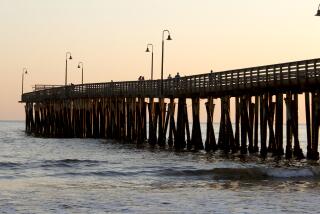Rival Villages : Chumash: Two groups plan to build replicas in the Thousand Oaks area. Some Indian community members are unhappy.
- Share via
Equipped only with knives and machetes, a group of builders is slowly constructing a replica of a traditional Chumash lodge at the foot of Boney Mountain in Newbury Park.
Fashioned from 16-foot-long willow boughs and cattail grass found in Ventura County riverbeds, the lodge is part of a Chumash cultural revival in Ventura County that is tinged with controversy.
The Satwiwa Culture Center is being built in the Santa Monica Mountains National Recreation Area under the supervision of the National Park Service. A predominantly non-Indian group called Friends of Satwiwa is constructing it as the first of two planned Chumash villages in the Thousand Oaks area.
The second, the Oakbrook Chumash Village, is to be built by the county Parks Department next year in the nearby city of Thousand Oaks with help from the Oakbrook Park Chumash Indian Corp.
Rather than delighting the Chumash community, the two planned villages have created something of a rivalry.
“A lot of Chumash don’t like it,” said Richard Angulo, council chief to the California Indian Council of the Satwiwa village.
“There’s going to be two villages in the same city. That’s going to be a conflict,” Angulo added.
Angulo said he plans to raise the issue with his council, which represents Indians of Chumash and Gabrieleno descent from Ventura and Los Angeles counties, in December.
The Oakbrook village, part of a complex including a $1.35-million park and a 4,200-square-foot museum that the county plans to build on 423 acres in northern Thousand Oaks, will be managed by the Indian corporation, said Ron Blakemore, the county’s manager of planning and development.
Blakemore said he sees no problem in having two Chumash villages.
“I think the two sites will complement each other. I hope that they won’t be identical,” Blakemore said. Construction of the county’s Oakbrook village is expected to start in February, he said.
The controversy over the rival villages has not been the only clash over Chumash issues. Last year, Leo Valenzuela, chairman of the Oakbrook group, said he and Kote Lotah, one of the builders of the village at Satwiwa, differed over where to rebury Chumash remains unearthed five years ago by the county.
The dispute was settled in March, 1989, after both sides agreed that the remains would be buried at Oakbrook, Valenzuela said.
Phil Holmes, a park ranger and anthropologist at the Santa Monica Mountains National Recreation Area, said he has helped both organizations in their efforts to build separate facilities.
“We want to try to foster cooperation,” Holmes said. “The ideal situation would be to have two strong centers.”
Both centers would have museums, a traditional Chumash village and programs for children and adults, Holmes said. Organizers for both centers claim a longtime involvement with the Chumash community in Ventura County.
Fund raising for the village on the national park is conducted by Friends of Satwiwa, a non-Indian group of donors headed by a Chumash leader. Joining in the initial construction have been three volunteers of Chumash descent and about 50 non-Indian novices.
Friends of Satwiwa so far has raised $77,000 but needs $300,000 to complete the village and cultural center. The group has until Feb. 28 to raise $100,000 to qualify for a $50,000 grant from the Santa Monica Mountains Conservancy.
Lotah, 45, one of the Chumash volunteers in the Satwiwa project, acknowledges that there is disagreement in the Chumash community but downplays the competition.
“Our primary concern is educating children,” Lotah said.
Lotah said his efforts are also directed at non-Indian groups that believe the Chumash are extinct. Much of Chumash history was lost after Spaniards settled California 500 years ago. Burial grounds have been destroyed or buried under new development.
Historians estimate that between 15,000 and 25,000 Chumash once populated the coastal region that eventually became Ventura, Santa Barbara and San Luis Obispo counties.
Today about 4,000 people of Chumash descent live in Santa Barbara and Ventura counties, most of them at a reservation in Santa Ynez.
Chumash history was very much alive for the Indians and non-Indians who recently spent the day working on the Chumash lodge.
Under the direction of Lotah’s stepson, Qun’tan Garcia, 21, the group finished the skeleton for the lodge, called an ap in the Chumash language. Subsequent groups are expected to cover it with grass thatching.
Garcia, who frames houses for a living, has been building Chumash lodges since he was 14.
“This is the main part of my life that I wouldn’t want to lose,” Garcia said.
Others ranging in age from 7 to the 60s said working on the lodge was like stepping back into time.
“You can read about it, but there’s nothing like hands-on work,” said Sue Milner, 60, of Pacific Palisades, as she vigorously stripped a willow branch using only a butter knife.
Milner, a docent from Topanga Canyon, said she had read up on Indian history. After hours of hard work, Milner stood by as others dug holes and used their feet to soften bark into pliable strips. She said there is still much to learn.
“The Indians probably taught us a thing or two,” she said.
Westlake Village Cub Scout Jimmy Selin, 7, used his fingers to dig a hole about a foot deep for one of the supporting boughs. He said he planned to build a mini-lodge of his own.
“I’ve been saving little sticks in my back yard,” Jimmy said.
More to Read
Sign up for Essential California
The most important California stories and recommendations in your inbox every morning.
You may occasionally receive promotional content from the Los Angeles Times.









